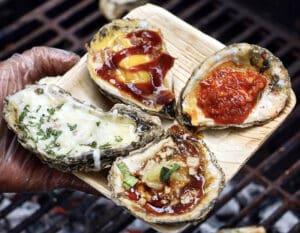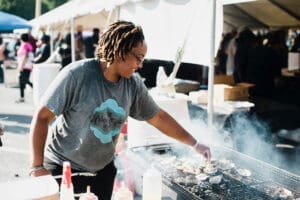
In the mid-19th century, most oysters consumed in the U.S. came from the Chesapeake Bay: the teeming estuary shared by Maryland and Virginia where people have been harvesting these bivalves for thousands of years. And many of those who helped make the era’s Chesapeake oyster industry the largest in the world — working the boats, gathering the shellfish with long tongs, shucking the catch and processing and packing the meat — were Black.
In an 1880 census of York County, Virginia, writes Ki’Amber Thompson for the Ocean Conservancy, “Black oystermen outnumbered White oystermen by four to one.” In fact, there is a long history of Black watermen in the oyster industry all along the Eastern Seaboard and Gulf Coast, though those contributions to the U.S. food system have been largely overlooked. Often, the work was grueling: The first Black oystermen in this country were enslaved, and after Emancipation, sharecropping-style arrangements were common. Workers often faced unfair wages, dangerous conditions and racist laws that inhibited their ability to work for themselves. But oystering was long one of the main industries where free Black people could find employment — even providing a path to “official” citizenship at a time when the designation was legally restricted to white people — and some went on to captain ships or own processing plants and oyster bars.
Oystering was a way of life in Black communities from New Orleans to New Jersey, where towns with names like Bivalve and Shellpile sprang up to accommodate migrant workers relocating to the North. One of the oldest continuously inhabited communities founded by free Black Americans is Rossville, New York, on nearby Staten Island — once an oystering haven called Sandy Ground. These days, however, Black involvement in the oyster industry is on the decline, and there are efforts to make sure this storied history is documented and disseminated: organizations like Blacks of the Chesapeake, filmmakers like “Vanishing Pearls” director Nailah Jefferson and projects undertaken by the Virginia Department of Historic Resources, New Jersey’s Bayshore Center at Bivalve and other researchers and institutions.
The Black history of oysters is also top of mind for many chefs, like Jasmine Norton, chef-owner of The Urban Oyster in her native Baltimore. Norton grew up eating oysters, and she learned to shuck them herself at a young age — but she also noticed that, though Chesapeake shellfish remains famous, many in her hometown found it inaccessible or unfamiliar. In 2017, she founded The Urban Oyster as a roving raw-bar pop-up, to her knowledge the first Black woman-owned oyster bar in the country; her brick-and-mortar restaurant opened in the neighborhood of Hampden early 2024. On the menu: fried oysters in tacos or atop deviled eggs; chargrilled oysters, a New Orleans special with roots in the region’s Black culinary traditions; and, of course, a rotating raw-bar list.
We spoke with Norton about her project, her love of oysters and building a more inclusive oyster industry.
I'm curious to hear from you, first, how you got interested in oysters and what your relationship is to them?
I don’t, to my knowledge, have any specific connection to oysters down my family lineage or anything like that — but I come from a major high consumption of seafood and oysters family. My dad is who introduced me to oysters, when I was about seven. And that was kind of like a bonding experience for him and I.
Have you always worked with oysters, as a chef?
I’ve never worked in anyone else’s kitchen. I started my journey at The Urban Oyster, and I chose oysters because of the history in African American culture — many oystermen were African American, even [going back to] the slavery era. So for me, it didn’t really make a lot of sense to me that so many African Americans lack the appreciation for oysters. Most people, even. There’s always been this air about raw food, raw oysters, and how slimy they look, the texture.
So I wanted to pique people’s interest. I wanted them to be a little more open minded about their palates when it comes to food. Because there’s so much labor that came behind it. Have the appreciation, as the consumer, for the journey of how it is harvested and brought to us. We certainly should at least explore the idea of it given the [issues of] equity in the labor space.
Have you learned anything about the role of oysters in Black cooking traditions?
Oysters were kind of regarded as this poor man’s food, right? Years ago, people would eat them when they didn’t have a lot of money — like lobster or undesirable pieces of meat. So there were a lot more people, African Americans, consuming them back then. Most people are now, or even decades ago, no longer depending on them.
But then oysters transition to this delicacy — and that’s where the access point comes back, with them being in places that we may not have access to, like a fine dining space. And so I think that’s where we’re now trying to balance this thing between access and approachability.

A variety of chargrilled oysters prepared by chef Jasmine Norton. Photo courtesy of The Urban Oyster
How are you working on that approachability aspect?
With trying to address the reservations that I mentioned — they’re textural and slimy and all these sorts of things — we borrow from the cooking technique of charbroiled oysters in New Orleans, cooking them and putting toppings that we eat on other things, and in other cuisines, just to make them more approachable. And I think that’s definitely worked.
When I started The Urban Oyster, you really couldn’t go a lot of places to get chargrilled oysters. You had to go out of your way and go to New Orleans — which is always a great time, but it’s nice to be able to experience it in Baltimore and not have to wait so long for your family vacation so you can say, like, “I finally tried oysters because I went to New Orleans and had them chargrilled, because that’s the only way I would eat them.”
What's been the response from the community in Baltimore? Are people getting excited about oysters through what you're doing?
Oh, absolutely. I think it just really comes down to — and that’s what we try to do with our full-on menu, not even just oysters — we try to make sure that we have a balance of ingredients that are unfamiliar as well as familiar, because there has to be a way to bridge the gap, to actually have a person be inclined to try something they’ve never experienced. And [for the chargrilled oysters], it’s very enticing and intriguing for people to wait and see what our next flavor is going to be.
Where do you source your oysters from?
The majority of our oysters come from the [Chesapeake] Bay. It’s our goal to contribute to the local ecosystem. But we also have some oysters that come from Massachusetts, we have some that come from Prince Edward Island — just so that we can have a well-rounded oyster bar.

Chef Norton behind the grill. Photo courtesy of The Urban Oyster.
You mentioned that historically oystering was very diverse, that there were a lot of black folks involved. Is that still he case with aquaculture os it a very white industry at this point?
I would say that it is not as diverse, and I think the reason why it was more diverse then is because, in all honesty, [a lot of] it was most likely forced labor. Whereas today, you know, you have a choice in the matter — but also, going back to that access conversation, a lot of us didn’t necessarily own boats and whatever else that was required to be an oysterman. We may own the skill and the trade, but we don’t own the materials, we don’t own the land.
And so [the oyster industry] is just a hard thing to come into, frequently. Definitely with African Americans, there are some out there, but it’s not a lot. We’re actually in the process of trying to find a way to have our own farm or partner with a farmer ourselves, and you know, it’s not a lot of them out there.
If readers were interested in supporting Black folks in the oyster space, is there anyone who you'd want to shout out?
I would definitely tell people to follow Minorities in Aquaculture [@mia_npo on Instagram]. There’s a woman named Imani who runs that organization and she is phenomenal, and definitely one trying to establish and grow the roots for minorities, but also women, in this space.







